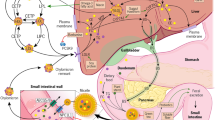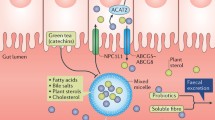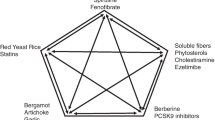Abstract
Hyperlipidemia is a risk factor for the development of coronary heart disease. Many patients decline prescription lipid-lowering agents and opt instead for supplements. Before any supplement can be routinely recommended it is crucial to examine the types of clinical trials that have been performed, the mechanism by which a supplement is felt to alter lipids, the population studied, potential adverse effects, and the possibility that investigators might be biased. Clinical trial evidence strongly supports the notion that both red yeast rice and plant stanols and sterols effectively lower low-density lipoprotein (LDL) cholesterol. Preliminary evidence supports the possibility that green tea catechins and black tea theaflavins may lower LDL. Data do not support an LDL-lowering claim for guggulipid, policosanol, or cinnamon. Finally, there is strong clinical trial evidence suggesting that marine omega-3 fatty acids lower triglycerides.
Similar content being viewed by others
References and Recommended Reading
Williams A: As economy is down, vitamin sales are up. NY Times April 4, 2009.
Heber D, Yip I, Ashley J, et al.: Cholesterol lowering effects of a proprietary Chinese red-yeast rice supplement. Am J Clin Nut 1999, 69:231–236.
Rippe J, Bonovich K, Colfer H, et al.: A multicenter self-controlled study of Cholestin in subjects with elevated cholesterol (poster presentation (p88)). Presented at the 39th Annual Conference on Cardiovascular Disease Epidemiology and Prevention, Orlando, Florida, USA March 24–27, 1999. Circulation 1999, 99:1123.
Becker DJ, Gordon RY, Morris PB, et al.: Simvastatin vs therapeutic lifestyle changes and supplements: randomized primary prevention trial. Mayo Clin Proc 2008, 83:758–764.
Lu Z, Kou W, Du B, et al.: Effect of xuezhikang, an extract from red yeast Chinese rice, on coronary events in a Chinese population with previous myocardial infarction. Am J Cardiol 2008, 101:1689–1693.
Pharmanex: Cholestin. Available at http://www.Pharmanex.com/corp/library/pdf/pip/cholestin.pfd Accessed April 2009.
Heber D, Lembertas A, Lu QY, et al.: Analysis of nine proprietary Chinese red yeast rice dietary supplements: Implications of variability in chemical profile and contents. J Altern Compl Med 2001, 7:133–139.
Katan MB, Grundy SM, Jones P, et al.: Efficacy and safety of plant stanols and sterols in the management of blood cholesterol levels. Mayo Clin Proc 2003, 78:965–978.
Food and Drug Administration, Department of Health and Human Services: Food labeling: health claims: plant sterol/stanol esters and coronary heart disease. Fed Register 2000, 65:54685–54739.
Maki KC, Davidson MH, Umporowicz DM, et al.: Lipid responses to plant sterol-enriched reduced-fat spreads incorporated into a National Cholesterol Education step 1 diet. Am J Clin Nutr 2001, 74:33–43.
Blair SN, Capuzzi DM, Gottlieb SO, et al.: Incremental reduction of serum total cholesterol with the addition of plant stanol ester-containing spread to statin therapy. Am J Cardiol 2000, 86:46–52.
Goldberg AC, Ostlund RE, Bateman JH, et al.: Effect of plant stanol tablets on low-density lipoprotein cholesterol lowering in patients on statin drugs. Am J Cardiol 2006, 97:376–379.
Gylling H, Radhakrishnan R, Miettinen TA: Reduction of serum cholesterol in postmenopausal women with previous myocardial infarction and cholesterol malabsorption induced by dietary sitostanol ester margarine. Circulation 1997, 96:4226–4231.
Demonty I, Ras RT, van der Knaap HC, et al.: Continuous dose-response relationship of the LD-cholesterol-lowering effect of phytosterol intake. J. Nutr 2009, 139:271–284.
Plat J, van Onselen EN, van Heugten MM, Mensink RP: Effects on serum lipids, lipoproteins and fat soluble antioxidant concentrations of consumption frequency of margarines and shortenings enriched with plant stanol esters. Eur J Clin Nutr 2000, 54:671–677.
Richelle M, Enslen M, Hager C, et al.: Both free and esterified plant sterols decrease the bioavailability of betacarotene and alpha-tocopherol, in normocholesterolemic humans. Am J Clin Nutr 2004, 80:171–177.
Noakes M, Clifton P, Ntanios F, et al.: An increase in dietary carotenoids when consuming plant sterols or stanols is effective in maintaining plasma carotenoid concentrations. Am J Clin Nutr 2002, 75:79–86.
Vermeer MA, Mulder TP, Molhuizen HO: Theaflavins from black tea, especially theaflavin-3-gallate, reduce the incorporation of cholesterol into mixed micelles. J Agric Food Chem 2008, 56:12031–12036.
Bursill C, Roach PD, Bottema CD, et al.: Green tea upregulates the low-density lipoprotein receptor through the sterol-regulated element binding protein in HepG2 liver cells. J Agric Food Chem 2001, 49:5639–5645.
Maron DJ, Lu GP, Cai NS, et al.: Cholesterol lowering effect of a theaflavin-enriched green tea extract. Arch Intern Med 2003, 163:1448–1453.
Jujita H, Yamagami T: Antihypercholesterolemic effect of Chinese black tea extract in human subjects with borderline hypercholesterolemia. Nutr Res 2008, 28:450–456.
Japan Atherosclerosis Society: Guidelines for Hyperlipidemia [Japanese]. Tokyo, Japan: Nanzando; 2002.
Nityanand S, Kapoor NK: Cholesterol lowering activity of the various fractions of guggul. Indian J Exp Biol 1973, 11:395–398.
Urizar NL, Liverman AB, Dodds DT, et al.: A natural product that lowers cholesterol as an antagonist ligand for FXR. Science 2002, 296:1703–1706.
Satyavati GV: Gum guggal (Commiphor mukul)—the success story of an ancient insight leading to a modern discovery. Indian J Med Res 1988, 87:327–329.
Singh RB, Niaz MA, Ghosh S: Hypolipidemic and antioxidant effects of Commiphora mukul as an adjunct to dietary therapy in patients with hypercholesterolemia. Cardiovasc Drugs Ther 1994, 8:659–664.
Szapary PO, Wolfe ML, Bloedon LA, et al.: Guggulipid for the treatment of hypercholesterolemia: a randomized controlled trial. JAMA 2003, 290:765–772.
Bianchi A, Firenzuoli F, Mazzanti G, et al.: Rhabdomyolysis caused by commiphoroa mukul, a natural lipid lowering agent. Ann Pharmacother 2004, 38:1222–1225.
Gouni-Berthold I, Berthold HK: Policosanol: clinical pharmacology and therapeutic significance of a new lipidlowering agent. Am Heart J 2002, 143:356–365.
Berthold HK, Unverdorben S, Degenhardt R, et al.: Effects of policosanol on lipid levels among patients with hypercholesterolemia or combined hyperlipidemia: a randomized controlled trial. JAMA 2006, 295:2262–2269.
Janikula M: Policosanol: a new treatment for cardiovascular disease? Altern Med Rev 2002, 7:203–217.
Menendez R, Amor AM, Rodeiro I, et al.: Policosanol modulates HMG-CoA reductase activity in cultured fibroblasts. Arch Med Res 2001, 32:8–12.
Dulin MF, Hatcher LF, Sasser H, Barringer TA: Policosanol is ineffective in the treatment of hypercholesterolemia: a randomized controlled trial. Clin Nutr 2006, 84:1543–1548.
Cubeddu LX, Cubeddu RJ, Heimowitz T, et al.: Comparative lipid-lowering effects of policosanol and atorvastatin: a randomized, parallel, double-blind, placebo-controlled trial. Am Heart J 2006, 152:982e1–982e5.
Jarvill-Taylor KJ, Anderson RA, Graves DJ: A hydroxychalcone derived from cinnamon functions as a mimetic for insulin in 3T3-L1 adipocytes. J Am Coll Nutr 2001, 20:327–336.
Khan A, Sefad M, Khan MM, et al.: Cinnamon improves glucose and lipids of people with type 2 diabetes. Diabetes Care 2003, 26:3215–3218.
Mang B, Wolters M, Schmitt B, et al.: Effects of cinnamon extract on plasma glucose, HbA1c, and serum lipids in diabetes mellitus type 2. Eur J Clin Invest 2006, 36:340–344.
Vanschoonbeek K, Thomassen BJ, Senden JM, et al.: Cinnamon supplementation does not improve glycemic control in postmenopausal type 2 diabetic patients. J Nutr 2006, 136:977–980.
Kris-Etherton PM, Harris WS, Appel LJ: Fish consumption, fish oil, omega-3 fatty acids and cardiovascular disease. Circulation 2002, 106:2747–2757.
Omega-3 polyunsaturated fatty acids (Omacor) for hypertriglyceridemia [no authors listed]. Med Lett Drugs Ther 2005, 47:91.
Durrington PN, Bhatnagar D, Mackness MI, et al.: An omega-3 polyunsaturated fatty acid concentrate administered for one year decreased triglycerides in simvastatin treated patients with coronary heart disease and persisting hypertriglyceridemia. Heart 2001, 85:544–548.
Harris WS: N-3 fatty acids and lipoproteins: Comparison of results from human and animal studies. Lipids 1996, 31:243–252.
Chan DC, Watts GF, Mori TA, et al.: Randomized controlled trial of the effect of n-3 fatty acid supplementation on the metabolism of apolipoprotein B-100 and chylomicron remnants in men with visceral adiposity. Am J Clin Nutr 2003, 77:300–307.
Harris WS, Lu G, Rambjor GS, et al.: Influence of n-3 fatty acid supplementation on the endogenous activities of plasma lipases. Am J Clin Nutr 1997, 66:254–260.
Park Y, Harris WS: Omega-3 fatty acid supplementation accelerates chylomicron triglyceride clearance. J Lip Res 2002, 44:455–463.
DeCaterina R, Bertolotto A, Madonna R, Schmidt EB: N-3 fatty acids in the treatment of diabetic patients. Diabetes Care 2007, 30:1012–1026.
Author information
Authors and Affiliations
Corresponding author
Rights and permissions
About this article
Cite this article
McGowan, M.P., Proulx, S. Nutritional supplements and serum lipids: Does anything work?. Curr Atheroscler Rep 11, 470–476 (2009). https://doi.org/10.1007/s11883-009-0070-2
Published:
Issue Date:
DOI: https://doi.org/10.1007/s11883-009-0070-2




